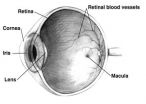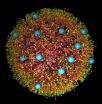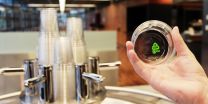Wireless nanorod-nanotube film enables light stimulation of blind retina
Breakthrough could lead to artificial retinas for visually impaired; groundbreaking wireless material triggers brain activity in response to light
2014-12-03
(Press-News.org) Scientists have developed a new light-sensitive film that could one day form the basis of a prosthetic retina to help people suffering from retinal damage or degeneration. Hebrew University of Jerusalem researchers collaborated with colleagues from Tel Aviv University and Newcastle University in the research, which was published in the journal Nano Letters.
The retina is a thin layer of tissue at the inner surface of the eye. Composed of light-sensitive nerve cells, it converts images to electrical impulses and sends them to the brain. Damage to the retina from macular degeneration, retinitis pigmentosa and other conditions can reduce vision or cause total blindness. In the United States alone, age-related macular degeneration (AMD) affects as many as 15 million Americans, with over 200,000 new cases diagnosed every year.
Scientists are currently designing a variety of medical devices to counter the effects of retinal disorders by sending visual signals to the brain. But these silicon-chip based solutions are typically hampered by their size, use of rigid parts, or requirement of external wiring such as to energy sources.
In the new study, Hebrew University researchers collaborated with colleagues from Tel Aviv University and Newcastle University to develop a novel approach for retina stimulation. Their device absorbs light and stimulates neurons without using wires or external power sources.
The Hebrew University researchers are Prof. Uri Banin, the Alfred & Erica Larisch Memorial Chair in Solar Energy, and his graduate student Nir Waiskopf, at the Institute of Chemistry and the Harvey M. Krueger Family Center for Nanoscience and Nanotechnology.
The researchers combined semiconductor nanorods and carbon nanotubes to create a wireless, light-sensitive, flexible implantable film. The film transforms visual cues to electric signals, mimicking the function of the photo-sensitive cells in the retina. Therefore, it could potentially form part of a future prosthetic device that will replace the damaged cells in the retina.
The researchers tested the new device on light-insensitive retinas from embryonic chicks and observed a neuronal response triggered by light.
According to the researchers, the new device is compact, capable of higher resolution than previous designs, and is also more effective at stimulating neurons. While much work remains until this can provide a practical solution, with additional research the researchers hope their carbon nanotube-semiconductor nanocrystals film will one day effectively replace damaged retinas in humans.
Prof. Uri Banin of the Hebrew University said: "This is a pioneering work demonstrating the use of highly tailored semiconductor nanocrystals in activation of biomedical functionalities. We hope this can lead to future implementation of this approach in retinal implants."
INFORMATION:
The researchers received funding from the Israel Ministry of Science and Technology, the European Research Council and the Biotechnology and Biological Sciences Research Council.
The research was published in Nano Letters as "Semiconductor Nanorod-Carbon Nanotube Biomimetic Films for Wire-Free Photostimulation of Blind Retinas."
[Attachments] See images for this press release:

ELSE PRESS RELEASES FROM THIS DATE:
2014-12-03
A new research brief from the US2010 Project probes the status of minorities in American suburbs. Suburbs in 2010 were as racially and ethnically diverse as were central cities in 1980, and that diversity is still increasing. Yet minorities are not finding equal access to the American dream in the suburbs where they live, a lesson illustrated recently by Ferguson, MO.
Suburbia has always been less segregated than central cities. Segregation is slowly declining between suburban blacks and whites, but has stayed about the same for Hispanics and Asians over three decades. ...
2014-12-03
Do you consider yourself a conscientious person? Then sign up for a fixed-rate mortgage. Neurotic? You'll probably opt for home ownership over renting.
According to a new study published in the Journal of Behavioral and Experimental Economics, personality traits are strong indicators of real-estate decisions. The research, by Dr. Danny Ben-Shahar of Tel Aviv University's Faculty of Management and doctoral candidate Roni Golan of the Technion Institute of Technology, finds a correlation between personality and individual real estate choices, and a follow-up study by the ...
2014-12-03
Those wishing to prove themselves as "doers" must not only be hands-on and demonstrate proactive behavior but also have social acumen and a feel for favorable opportunities. Those who rely on personal initiative alone will quickly be standing there as an isolated troublemaker. This is what psychologists from the University of Bonn and their colleagues from Florida State University (USA) have discovered through surveying a variety of occupational categories. The results have been published online in the renowned "Journal of Management". The printed version will be published ...
2014-12-03
Learning from others and innovation have undoubtedly helped advance civilization. But these behaviours can carry costs as well as benefits. And a new study by an international team of evolutionary biologists sheds light on how one particular cost - increased exposure to parasites - may affect cultural evolution in non-human primates.
The results, published Dec. 3, 2014, in the journal Proceedings of the Royal Society B, suggest that species with members that learn from others suffer from a wider variety of socially transmitted parasites, while innovative, exploratory ...
2014-12-03
This news release is available in German.
(Jena/Germany) Jena scientists have been successful in producing highly specific nanoparticles. Depending on the bound dye the particles are guided to the liver or to the kidney and deliver their payload of active ingredients directly to the targeted tissue. Moreover, the dyes enable the tracking of the transport processes by intravital microscopy or, in a non-invasive way, by multi spectral optoacoustic tomography. The reduction of cholesterol production induced by siRNA served as the proof-of-principle for the developed ...
2014-12-03
What do lasers, neural networks, and spreading epidemics have in common? They share a most basic feature whereby an initial pulse can propagate through a medium - be it physical, biological or socio-economic, respectively. The challenge is to gain a better understanding - and eventually control - of such systems, allowing them to be applied, for instance to real neural systems. This is the objective of a new theoretical study published in EPJ B by Clemens Bachmair and Eckehard Schöll from the Berlin University of Technology in Germany. Ultimately, with a better theoretical ...
2014-12-03
New research from the University of Adelaide has helped to shed light on the complexities of child sleep, and could lead to improved diagnosis of children with sleep-related breathing problems.
For his PhD in the University's School of Medical Sciences, Scott Coussens has been investigating how to accurately measure the level of sleep disturbance being experienced by children, to show whether or not they require treatment.
"Quality sleep is extremely important for children, especially at critical times of development. It can impact on the health of the brain and plays ...
2014-12-03
New Rochelle, NY, December 3, 2014--Are adolescents who view pornography or music videos more likely to engage in sexting, in which they share sexually explicit content via text, photo, or video using cell phones, email, or social networking sites? A study of the media consumption and sexting behavior of more than 300 teens is published in Cyberpsychology, Behavior, and Social Networking, a peer-reviewed journal from Mary Ann Liebert, Inc., publishers. The article is available free on the Cyberpsychology, Behavior, and Social Networking website.
In "The Associations ...
2014-12-03
Plastic waste is one of today's major environmental concerns. Most types of plastic do not biodegrade but break up into ever smaller pieces while remaining a polymer. Also, most types are made from oil, a rapidly dwindling resource. But there are promising alternatives, and one of them is polylactic acid (PLA): it is biodegradable and made from renewable resources. Manufacturers use PLA for disposable cups, bags and other sorts of packaging. The demand for PLA is constantly rising and has been estimated to reach about one megaton per year by 2020.
The research groups ...
2014-12-03
Planets orbiting close to low-mass stars -- easily the most common stars in the universe -- are prime targets in the search for extraterrestrial life.
But new research led by an astronomy graduate student at the University of Washington indicates some such planets may have long since lost their chance at hosting life because of intense heat during their formative years.
Low-mass stars, also called M dwarfs, are smaller than the Sun, and also much less luminous, so their habitable zone tends to be fairly close in. The habitable zone is that swath of space that is just ...
LAST 30 PRESS RELEASES:
[Press-News.org] Wireless nanorod-nanotube film enables light stimulation of blind retina
Breakthrough could lead to artificial retinas for visually impaired; groundbreaking wireless material triggers brain activity in response to light



